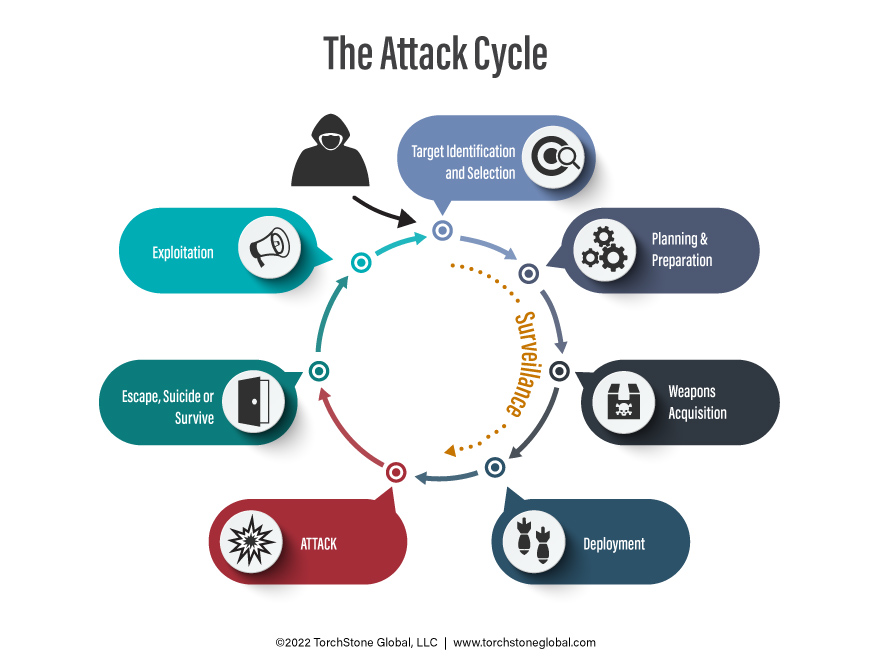
Kidnapping Part 2: High-Value Kidnapping for Ransom
By TorchStone VP, Scott Stewart
A high-value kidnapping for ransom is a crime in which a person of significant personal wealth or status is specifically targeted and then kidnapped for a sizable ransom.
These complex kidnappings are often led by professional criminals and carried out by personnel chosen for their specialized skills, such as drivers, gunmen, and surveillance specialists.
Professional criminals prefer high-value kidnappings over express and virtual kidnappings, often carried out by less proficient criminals, because of the potential for a large payoff.
Some criminals also like the challenge of pulling off a dangerous high-value kidnapping.
Unlike an armored car heist or a bank robbery, kidnappings are rarely reported to the authorities in many countries, allowing some kidnapping gangs to operate for years without coming to the attention of the authorities.
Kidnapping gangs typically follow an attack cycle much like the one illustrated here:

During the target identification and selection phase of the attack cycle, the kidnappers will often look at several potential targets and then conduct extensive online research and use physical surveillance to determine the target’s assets, behavioral patterns, security measures, and vulnerabilities.
The criminal planners then use the results of their research to select a target they believe is both vulnerable and likely to produce a ransom amount worth the effort.
Planning
Due to their complexity, kidnappings for ransom require a much more thorough planning process than what goes into most crimes.
Once a target has been selected, more intensive surveillance is conducted to determine when and where the target is most vulnerable for a successful abduction attempt.
They will also look for an abduction site that offers them the ability to deploy without detection, control the target’s movement, and allows for a quick escape.
Sometimes as part of the intelligence collection process, the kidnappers will also attempt to enlist the help of someone close to the target, especially workers with access to restricted areas or with knowledge of the target’s security, such as household staff.
An insider can provide valuable information about the target’s routines and life patterns and, in some cases, even provide the kidnappers with direct access to the victim.
While criminals such as bank robbers must conduct extensive research on their target, perform pre-operational surveillance and make escape plans, kidnappers must also arrange for a safe house, secure communications, and the ransom drop.
Generally, the safe house where a hostage is kept is located in an area the criminals can easily control and where they can operate with relative freedom and without fear of detection.
In some locales, this may be a remote rural area, while in others, it may be in a congested urban neighborhood or slum.
For a prolonged kidnapping, the safe house must be stocked with provisions to hold and feed the victim, as well as staffed with guards who can provide around-the-clock security for the facility.
In addition to the safe-house, kidnappers must make plans for secure communications amongst themselves and with the victim’s representatives when negotiating the ransom and arranging for the ransom drop and the victim’s release.
Planning for the ransom-victim exchange often requires the abductors to make elaborate arrangements to ensure their security and maximize their chances of escape.
These arrangements may include surveillance of the area to check for law enforcement and ensure that the victim’s representatives comply with instructions.
In many cases, the operational plan will also include a pre-established rendezvous point where the criminals will meet after the ransom drop.
The ransom drop itself is a delicate operation.
Things can often go wrong if the criminals get spooked or there is some other sort of misunderstanding.
In these cases, situations can go bad rapidly, resulting in either the capture of abductors or the abandonment or death of the victim.
Attack Phase
When kidnappers launch their attack, the abduction team will normally attempt to hit the victim with overwhelming force.
The danger to the victim is generally the highest during the abduction phase of the kidnapping when the guns are out and nerves are jumpy.
During this tense time, the victim’s ability to respond appropriately is vital.
In a well-planned kidnapping, the rapid execution and seemingly overwhelming force displayed by the abductors will leave the victim with little choice but to comply.
Resisting the kidnapper can sometimes work during the initial abduction.
But in a purely financial kidnapping, fighting back is probably not worth the risk unless the victim is well-trained and there is a clear way to escape from the abduction site.
If the victim is practicing good situational awareness and notices the attack as it is being launched and acts immediately—before the attack can be fully executed—they stand a better chance of escaping than if the victim is caught totally off guard and the kidnappers catch them flat-footed.
As noted in the first installment of this series, the FBI can deploy highly sophisticated resources in kidnapping investigations, and thus high-value kidnappings in the United States are very rare.
However, they do happen.
For instance, in January 2003, billionaire hedge fund manager and financier Edward Lampert was kidnapped in the parking garage of his Greenwich, Conn. office building by four armed men.
He was held hostage at a motel for 28 hours and was freed after he agreed to pay a $5 million ransom.
Fortunately, Lampert outwitted his captors, never paid a penny, and all four men were arrested within days.
The Lampert case is noteworthy because it demonstrates that even bumbling criminals can abduct a high-value target in the United States if proper security precautions are not taken, and the criminals are given free rein to plan and execute their attack.
In another example, tax accountant Pedro Portugal was kidnapped while walking on the street in Queens, New York, in April 2013.
Portugal was held for over a month in a dilapidated warehouse in Long Island City while his kidnappers demanded a $3 million ransom from his family in Ecuador.
When the family said they could not pay such a large sum, Portugal’s captors responded by beating him severely and burning him with acid.
However, for most Americans, the most acute kidnapping risk occurs when they travel abroad, especially to countries such as Mexico, Colombia, or Nigeria, where kidnapping thrives due to a lack of law and order and corrupt authorities who are often complicit.
Kidnapping is Avoidable
Kidnappings for ransom are almost always avoidable crimes because of the significant surveillance and other planning required to conduct the crime properly.
The surveillance phase of the attack planning process simply cannot be skipped.
As the kidnappers conduct surveillance, they make themselves vulnerable to detection.
Criminals are normally bad at surveillance, but they get away with such poor surveillance tradecraft because people are generally not looking for them.
Another reason why kidnappers get away with poor surveillance tradecraft is that victims deny that they are being targeted.
I debriefed an American businessman kidnapped in Guatemala City in 1995, and he told me he repeatedly saw a suspicious person sitting on a bench in a park near his home.
However, he did not pay much attention to the man because he did not consider himself wealthy enough to be targeted for kidnapping.
Unfortunately, it was only during his two weeks of brutal captivity that he realized the preoperational indicators he had seen—and disregarded—prior to his abduction.
Denial can often prove to be deadly, but luckily for the businessman, in this case, it only cost him a serious beating, a couple of weeks of captivity, and two hundred thousand dollars instead of his life.
In addition to practicing good situational awareness and varying their routines to avoid patterns, potential victims can take other precautionary measures to avoid being kidnapped.
Executive Protection Professionals
The most effective and obvious measure is to employ a security driver or an executive protection detail.
Individuals with protective details are seldom taken, and security details that add route analysis, protective surveillance, and variance of routes and schedules to their repertoires seldom lose their charges.
This means that security details must maintain a high level of situational awareness vis-a-vis their surroundings, especially near known locations such as the principal’s residence and office and at any regular appointments or announced public events.
Routes regularly taken should be assessed and extra attention should be paid when the principal is passing through a choke point that would make an ideal abduction site.
By being aware of anything unusual or out of place at these high-risk places, the security detail and the principal have a good chance of spotting hostile surveillance or preparations for abduction.
An armored vehicle can also provide some additional security but are also no guarantee of safety, as there have been many kidnappings in which armored vehicles have been defeated.
Unfortunately, the presence of armed security alone is not guaranteed to protect against kidnapping.
We are unaware of a kidnapping for ransom in the United States in which the victim had a protection team, but there are ample examples in places like Mexico where the kidnappers have engaged and wounded or killed the victim’s security driver and/or bodyguard.
Protect Privacy and Vet Staff
In addition to maintaining physical security, other precautions can be taken to make an individual a more difficult target for kidnappers.
Minimizing the amount of personal information available to the public, such as information on the internet and in media interviews, can frustrate the planning efforts of potential kidnappers and require them to conduct additional surveillance to gather the information they require.
To this end, the principal, family members, household staff, and other employees should be briefed on the need to protect privacy and educated as to what kind of approaches indicate attempts by criminals to gather sensitive information on the principal.
This briefing should teach them what to report and who to report it to.
Household staff, contractors, and other temporary employees should also be thoroughly vetted.
Security teams and principals should learn about the personal lives of staff members and pay particular attention to new people in their lives.
I worked a case in which the victim’s housekeeper was recruited by a criminal who romanced her and bought her nice things to get her to provide inside information on the victim.
Naturally, the man the housekeeper thought was the love of her life never contacted her again after her employer was abducted.
The key to avoiding a kidnapping is to prevent the criminals from conducting surveillance at will or using other means to gather the intelligence they need to plan this complex crime.
Denying kidnappers access to the information they need will nearly always cause them to turn their attention to an easier target.
This report is the second in a series addressing different types of kidnapping and their motivations. The first part of the series, Understanding Kidnapping Threats, introduces different types of kidnapping. The third part, Express Kidnapping, examines how this crime of opportunity is no less dangerous for the victim. The fourth part of the series, Virtual Kidnapping, considers who the real victim is. The fifth part, Tiger Kidnapping, explains how victims are victimized again. The sixth and final part of the series, Crypto Kidnapping, centers on kidnappers who identify targets with large amounts of cryptocurrency.
